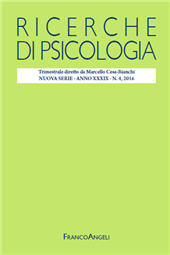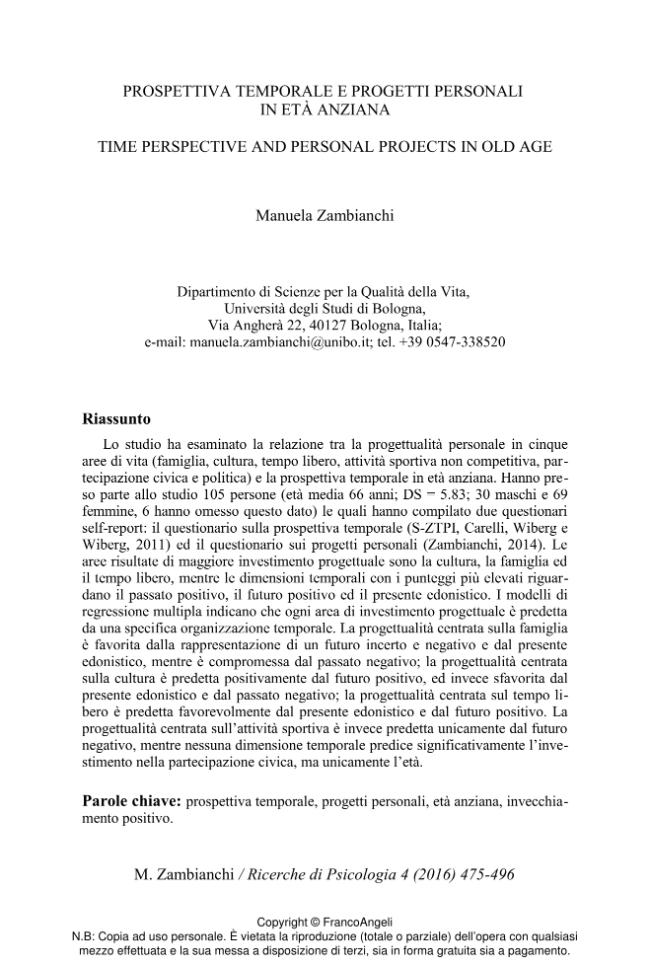Prospettiva temporale e progetti personali in eta anziana
475-496 p.
Lo studio ha esaminato la relazione tra la progettualità personale in cinque aree di vita (famiglia, cultura, tempo libero, attività sportiva non competitiva, partecipazione civica e politica) e la prospettiva temporale in età anziana. Hanno preso parte allo studio 105 persone (età media 66 anni; DS = 5.83; 30 maschi e 69 femmine, 6 hanno omesso questo dato) le quali hanno compilato due questionari self-report: il questionario sulla prospettiva temporale (S-ZTPI, Carelli, Wiberg e Wiberg, 2011) ed il questionario sui progetti personali (Zambianchi, 2014). Le aree risultate di maggiore investimento progettuale sono la cultura, la famiglia ed il tempo libero, mentre le dimensioni temporali con i punteggi più elevati riguardano il passato positivo, il futuro positivo ed il presente edonistico.
I modelli di regressione multipla indicano che ogni area di investimento progettuale è predetta da una specifica organizzazione temporale. La progettualità centrata sulla famiglia è favorita dalla rappresentazione di un futuro incerto e negativo e dal presente edonistico, mentre è compromessa dal passato negativo; la progettualità centrata sulla cultura è predetta positivamente dal futuro positivo, ed invece sfavorita dal presente edonistico e dal passato negativo; la progettualità centrata sul tempo libero è predetta favorevolmente dal presente edonistico e dal futuro positivo. La progettualità centrata sull'attività sportiva è invece predetta unicamente dal futuro negativo, mentre nessuna dimensione temporale predice significativamente l'investimento nella partecipazione civica, ma unicamente l'età. [Testo dell'editore].
The study examined the relationship between personal projects in five areas of life (family, culture, leisure time, not competitive sport, civic and political participation) and time perspective in old age. A sample of 105 old persons took part in the study (mean age 66 years, SD = 5.83; 30 males and 69 females, with 6 subjects that omitted this data). They filled in two self-report questionnaires: the Swedish questionnaire on time perspective (S-ZTPI, Carelli, Wiberg e Wiberg, 2011) and the questionnaire on personal projects (Zambianchi, 2014). The areas of major investment are culture, family and leisure time, while the highest temporal scores are on past positive, future positive, and present hedonistic. The multiple regression models highlight that each area of project investment is predicted by a specific temporal organization.
The projects centered on family are predicted and favored by a representation of the future as uncertain and negative and by present hedonistic, while they are undermined by the past negative. The projects centered on culture are positively predicted by future positive, while they are undermined by present hedonistic and past negative; the projects centered on leisure time are positively predicted by present hedonistic and by future positive. The projects about not competitive sport and physical activity are uniquely predicted by future negative, while any time perspective dimension significantly predicts the investment on civic participation, but only age. [Publisher's Text].
Fait partie de
Ricerche di psicologia : 4, 2016-
Articles du même numéro (disponibles individuellement)
-
Informations
Code DOI : 10.3280/RIP2016-004002
ISSN: 1972-5620
KEYWORDS
- Prospettiva temporale, progetti personali, età anziana, invecchiamento positivo
- Time perspective, personal projects, old age, positive aging



